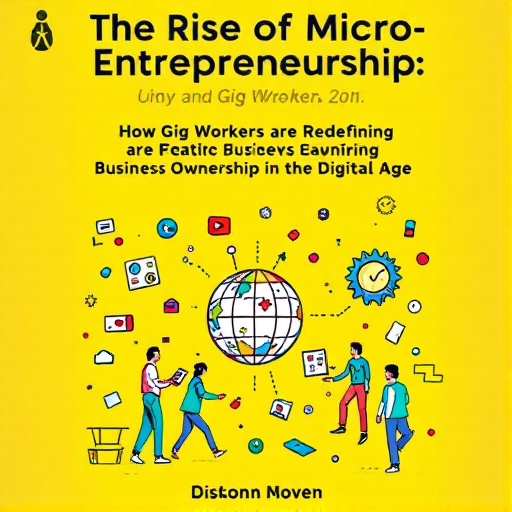Featured Articles
- 7 Best AI-Powered Marketing Platforms Released Since 2019 That Will Supercharge Your Startup Growth
- 9 Proven Psychological Tricks Entrepreneurs Use to Influence Buyers and Skyrocket Sales
- "From Side Hustle to Mainstream: The Surprising Rise of Entrepreneurial Niche Communities"
- The Rise of 'Accidental Entrepreneurs': How Unexpected Events Spark New Business Ventures
- The Rise of Eco-Entrepreneurship: How Green Startups Are Transforming Traditional Industries
The Rise of Micro-Entrepreneurship: How Gig Workers are Redefining Business Ownership in the Digital Age
The Rise of Micro-Entrepreneurship: How Gig Workers are Redefining Business Ownership in the Digital Age
The world of entrepreneurship is evolving, with gig work emerging as a vibrant and essential part of the economic landscape. In this article, we'll explore how micro-entrepreneurs are reshaping business ownership in the digital age, leveraging technology to create opportunities and redefine success.
The Gig Economy: A Brief Overview
In the past decade, the gig economy has exploded, with an estimated 36% of American workers engaging in some form of gig work, according to a 2020 report from Statista. This growth has not only reshaped the job market but also introduced a new paradigm for business ownership that emphasizes flexibility, autonomy, and innovation. Individuals are no longer bound by traditional employment structures; they can create their own paths, often from the comforts of their own homes.
Micro-Entrepreneurship Demystified
So, what exactly is micro-entrepreneurship? Picture a world where individuals can start their own businesses, often with little more than a smartphone and an internet connection. From selling homemade crafts on Etsy to driving for Uber, micro-entrepreneurship allows anyone to monetize their skills and talents without the overhead costs associated with traditional business models.
The Gen Z Factor: A New Age of Entrepreneurs
As a 25-year-old writer, I can’t help but appreciate the significance of my generation's role in this landscape. Many Gen Z members view traditional jobs less favorably, opting instead for the rollercoaster ride of gig work that offers them freedom and creativity. According to a 2021 Deloitte report, 70% of Gen Zs express a desire to start their own businesses, a stark contrast to the prior generations that often sought stability in employment.
The Power of Technology
Technology is the wind beneath the wings of micro-entrepreneurship. Apps like Upwork, Fiverr, and TaskRabbit have revolutionized how freelancers connect with clients, while platforms like Shopify and WooCommerce allow anyone to set up an online store with minimal investment. A statistic from the U.S. Bureau of Labor Statistics notes that over 47% of gig workers cite the flexibility of these platforms as a primary reason for engaging in gig work.
The Downsides: Navigating the Gig Economy
Despite its many benefits, the gig economy is not without drawbacks. Many gig workers face inconsistent income, lack of job security, and no employee benefits such as health insurance or retirement plans. This precarious nature often leads to a sense of insecurity, compelling some to question whether gig work is a sustainable long-term solution.
Case Study: The Story of Mia
Consider the story of Mia, a 28-year-old graphic designer from Chicago. After being laid off, she pivoted to freelance work, using platforms like Behance and Instagram to showcase her portfolio. Within six months, Mia secured several clients, transitioned to full-time freelancing, and even launched her own design agency—all without the need for significant startup capital. Today, she earns more than she did in her previous job, illustrating the possibilities that micro-entrepreneurship presents.
Soft Skills: The Unsung Heroes of Gig Work
As any successful micro-entrepreneur will tell you, technical skills are essential, but soft skills can often be the difference between mediocrity and exceptional success. Communication, time management, and adaptability are crucial for navigating client relationships and managing multiple projects. And let’s not forget the importance of self-discipline; with gig work, you can’t postpone your tasks like you might in a traditional job—deadlines wait for no one!
A Personal Anecdote: The Lesson From My Etsy Shop
Let me share a personal twist. A few years ago, I decided to open an Etsy shop selling hand-painted mugs. It started as a hobby, but with social media marketing and some trial and error, I returned a profit that far exceeded my initial expectations. While I faced challenges, like learning how to ship products efficiently, the experience was utterly fulfilling and opened doors I never knew existed.
Government and Policy Support
With the rising tide of micro-entrepreneurship, it’s crucial to discuss how governments are beginning to adapt their policies to support this growing sector. Some countries are introducing tax benefits for gig workers and creating programs aimed at providing training and resources for micro-entrepreneurs. For example, the Canadian government launched the Innovation, Science and Economic Development strategy, actively aiming to support startups and small businesses.
Consumer Behavior: A Shift Towards Support
Interestingly, consumers today are also leaning more towards supporting local and small businesses. In 2022, a survey by the National Retail Federation revealed that 60% of consumers prefer shopping from small businesses over large corporations, a shift that empowers micro-entrepreneurs further. This sentiment is largely driven by consumers’ desire to foster community and contribute to the local economy.
The Future of Work
As we look ahead, the future of work likely involves a blend of traditional employment and gig opportunities. Many professionals are choosing to diversify their income streams by combining freelance work with a part-time job. In fact, a report from McKinsey suggests that up to 50% of the U.S. workforce might be working under a hybrid model by 2030, combining the best of both worlds.
My Final Thoughts: Embracing Change
Whether you’re a seasoned entrepreneur or a curious teenager eager to explore business ownership, the rise of micro-entrepreneurship offers vast opportunities waiting to be seized. The key is to embrace change, stay adaptable, and always keep learning. The digital age has made it easier than ever to chase your dreams; it’s time to take the leap.
Conclusion: A Call to Action
In conclusion, the rise of micro-entrepreneurship is not merely a trend; it's a significant transformation in how we view and participate in the economy. Whether you’re in your teens exploring opportunities or a seasoned professional contemplating a career pivot, consider the gig economy as a viable route for business ownership. So, grab your laptop, harness your skills, and embark on your own entrepreneurial journey. Who knows? You might just create a flourishing enterprise, inspire others, and redefine what success looks like in the modern world!



